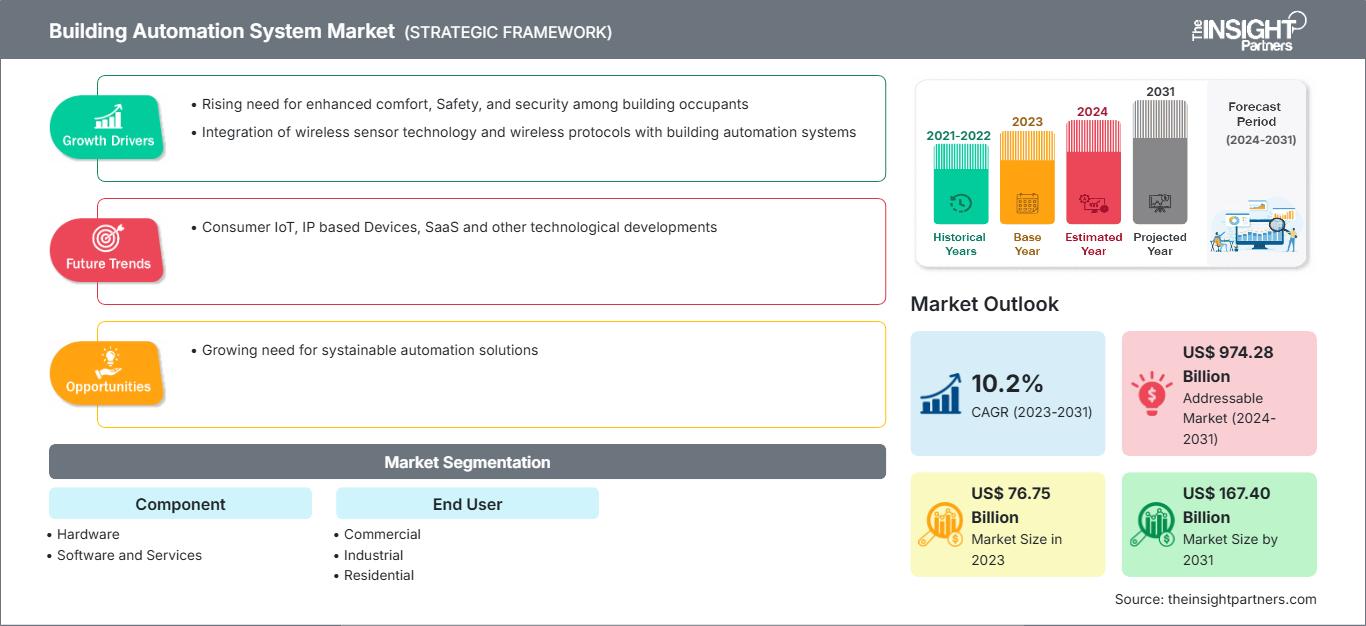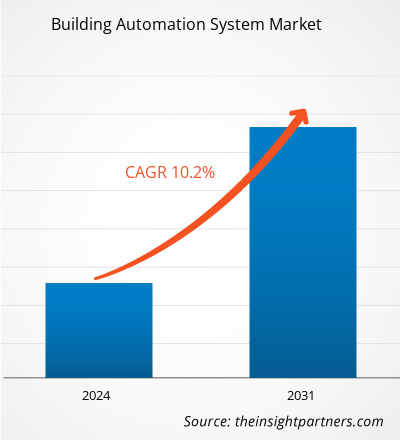ビルディングオートメーションシステム市場規模は、2023年の767.5億米ドルから2031年には1,674億米ドルに達すると予測されています。市場は2023年から2031年にかけて10.2%のCAGRを記録すると予想されています。消費者向けIoT、IPベースのデバイス、SaaS、およびその他の技術開発は、引き続き市場の主要トレンドとなる可能性があります。
ビルディングオートメーションシステム市場分析
建設活動の増加と世界的なスマートビルの需要の高まりが、市場の成長を促進する主な要因です。ビルディングオートメーションシステムは、高度なセンサー、アクチュエータ、およびネットワーク技術を使用して、HVAC、照明、セキュリティ、アクセス制御、エネルギー管理などのビルシステムの集中制御と監視を提供します。これらの技術は、建物の効率を最大化し、エネルギー使用量を削減し、施設管理手順を簡素化し、規制と基準の遵守を保証するように設計されており、ビルディングオートメーションシステム市場での需要をさらに高めています。 IoT、IPベースデバイス、SaaS、機械学習などの技術統合といった技術革新の高まりも、今後数年間で新たなトレンドをもたらすと予想されています。
ビルディングオートメーションシステム市場概要
ビルディングオートメーションシステム(BAS)は、接続されたすべてのビルシステムに単一のインターフェースからアクセス、制御、監視することを可能にします。BASテクノロジーにより、オーナーはネットワークに接続された電子機器を使用して、ビルの運用を一元管理できます。居住者の快適性を維持するために、システムは換気、湿度、照明、温度を制御します。占有センサーとスケジューリングは、使用されていないときに環境システムを変更することで、エネルギーの無駄を最小限に抑えます。さらに、すべてのシステムが最適な効率と精度で稼働することを保証します。予防保守が必要な場合は、センサーからオペレーターに通知されます。建物の防火、アクセス、監視システムはすべて統合されており、建物とそこにいる人々の安全を守ります。
要件に合わせてレポートをカスタマイズ
レポートの一部、国レベルの分析、Excelデータパックなどを含め、スタートアップ&大学向けに特別オファーや割引もご利用いただけます(無償)
ビルオートメーションシステム市場: 戦略的洞察

-
このレポートの主要な市場動向を入手してください。この無料サンプルには、市場動向から見積もりや予測に至るまでのデータ分析が含まれます。
ビルディングオートメーションシステム市場の推進要因と機会
快適性、安全性、セキュリティ強化へのニーズの高まり
ビルディングオートメーションシステムは、最先端の機器と技術を提供することで、建物のセキュリティシステムを強化します。建物利用者のセキュリティを強化し、資産、企業リソース、不動産、ITデータの保護に役立ちます。資産の損傷や盗難を防ぐだけでなく、従業員による改ざんや盗難を防ぐこともできます。建物内のエレベーターアクセス制御システムは、管理スタッフが立ち入り禁止と判断したフロアやエリアへのアクセスを制限します。さらに、このシステムはセキュリティ侵害を防ぎ、施設内の一時的な交通誘導を可能にします。アクセス制御管理における時間と曜日のスケジュール制約を使用することで、許可された担当者のみにアクセスを許可します。さらに、敷地内および建物内で行われるすべての活動は、アクセス制御ソフトウェアによって記録・保存されます。さらに、このシステムは、ガス漏れや火災などの安全上の潜在的な問題を検知し、これらのリスクを制限するために適切な措置を講じるようにプログラムすることもできます。
持続可能なビルディングオートメーションソリューションの必要性の高まり
持続可能なビルは、エネルギー消費と二酸化炭素排出量を最小限に抑えることを目指しています。BAS は、占有状況や環境条件に基づいて HVAC、照明、その他のシステムを監視、制御、最適化できます。太陽光や風力などの再生可能エネルギー源への移行が進むにつれて、BAS はビルの運用においてこれらの源の統合と利用をインテリジェントに管理し、最適なエネルギー使用と大幅なコスト削減を実現します。BAS は、エネルギー使用量と環境指標に関するリアルタイム データを提供し、エネルギー節約戦略と持続可能性の基準および規制への準拠について、情報に基づいた意思決定を促進します。持続可能なビルは、居住者の快適さと健康を最優先します。BAS は、室内の空気質を維持し、温度を調節し、自然光を最適化することで、居住者の満足度と生産性の向上に貢献します。また、持続可能なBASソリューションは、エネルギー費用の削減、メンテナンスの必要性の低減、機器寿命の延長によるコスト削減につながり、ビルの所有者や運営者にとって経済的に魅力的です。持続可能なソリューションの使用は、世界的な持続可能性の目標と一致しており、エネルギー効率の向上、居住者の快適性の向上、そしてビルの所有者や運営者に大きな経済的メリットをもたらします。したがって、業界全体で持続可能なビルディングオートメーションソリューションの需要が高まっていることから、予測期間中にビルディングオートメーション市場の成長に大きな機会が生まれると予想されます。
ビルディングオートメーションシステム市場レポートのセグメンテーション分析
ビルディングオートメーションシステム市場分析の導出に貢献した主要セグメントは、コンポーネントとエンドユーザーです。
- コンポーネントに基づいて、市場はハードウェア、ソフトウェア、サービスに分類されています。ハードウェアセグメントは2023年に大きな市場シェアを占めました。ビルディングオートメーションハードウェアは、センサーと制御装置を使用して、建物のユーティリティ、すなわち電気、暖房と空調、そして上下水道を監視および調整します。ビルディングオートメーションシステムのハードウェアコンポーネントには、サーモスタット(室温制御用)、占有センサー(照明制御用)、湿度センサー、火災・煙検知器、セキュリティ・監視システムなどがあります。ハードウェア市場はさらに、セキュリティ・監視システム、施設管理システム、防火システムなどに細分化されています。ビルディングオートメーションハードウェアを提供している企業には、Bosch Sicherheitssysteme GmbH、Lutron Electronics Co. Inc、Traneなどがあります。
- エンドユーザー別に見ると、市場は商業、工業、住宅に分類されます。2023年には商業セグメントが市場を席巻しました。商業ビルでは、占有率、季節、その他の重要なパラメータに基づいて内部温度と照明を管理するためにBASが実装されています。ビル制御システムは、冷暖房設備や照明システムの動作を制御し、施設内で任命された人員の生産性を刺激するための適切な環境を維持するとともに、特定のエリアが使用されていないときにエネルギーを節約します。さらに、商用BASの使用は、保守・管理担当者にとっても有益であることが証明されています。システムとコンポーネントのパフォーマンスは定期的に監視されており、異常が検出されるとチームに通知されます。
ビルディングオートメーションシステム市場シェア分析(地域別)
ビルディングオートメーションシステム市場レポートの地理的範囲は、主に北米、アジア太平洋、ヨーロッパ、中東・アフリカ、南米・中米の5つの地域に分かれています。
2023年のビルディングオートメーションシステム市場では、北米が最大のシェアを占め、次いでヨーロッパとアジア太平洋が続きました。北米市場は、地域全体の建設活動の増加といくつかの州の経済成長により、予測期間中に成長する見込みです。ビルディングオートメーションシステムは、エネルギー効率の向上に広く利用されており、これは直接的な経済的節約につながります。米国やカナダなどの国々では、スマートシティの建設が急速に進んでおり、予測期間中にビルディングオートメーションシステム市場の成長機会となることが期待されます。
ヨーロッパでは、建設業界が主に新築工事を中心に驚異的な成長を遂げており、これがこの地域のビルディングオートメーションシステム市場の成長を促進すると予想されています。ヨーロッパの建設業界は経済において重要な役割を果たしており、約1,800万人の雇用を生み出し、欧州連合(EU)全体のGDPの9%を占めています。建設業界は、住宅、産業、商業施設の新規建設、インフラの構築、そして老朽化した構造物や建物の維持・修繕に重点を置いています。ヨーロッパ各国の政府は、様々な大規模建設プロジェクトの立ち上げに積極的に関与しており、今後数年間でEUにおけるビルディングオートメーションシステムの導入が加速すると予想されています。
ビルディングオートメーションシステム
ビルディングオートメーションシステム市場の地域別分析
予測期間を通じてビルディングオートメーションシステム市場に影響を与える地域的な動向と要因については、The Insight Partnersのアナリストが詳細に解説しています。このセクションでは、北米、ヨーロッパ、アジア太平洋、中東・アフリカ、中南米におけるビルディングオートメーションシステム市場のセグメントと地域についても解説しています。
ビルディングオートメーションシステム市場レポートの範囲
| レポート属性 | 詳細 |
|---|---|
| の市場規模 2023 | US$ 76.75 Billion |
| 市場規模別 2031 | US$ 167.40 Billion |
| 世界的なCAGR (2023 - 2031) | 10.2% |
| 過去データ | 2021-2022 |
| 予測期間 | 2024-2031 |
| 対象セグメント |
By コンポーネント
|
| 対象地域と国 |
北米
|
| 市場リーダーと主要企業の概要 |
|
ビルディングオートメーションシステム市場のプレーヤー密度:ビジネスダイナミクスへの影響を理解する
ビルディングオートメーションシステム市場は、消費者の嗜好の変化、技術の進歩、製品メリットへの認知度の高まりといった要因によるエンドユーザー需要の高まりに牽引され、急速に成長しています。需要の増加に伴い、企業は製品ラインナップの拡充、消費者ニーズへの対応のためのイノベーション、そして新たなトレンドの活用を進めており、これが市場の成長をさらに加速させています。

- 入手 ビルオートメーションシステム市場 主要プレーヤーの概要
ビルディングオートメーションシステム市場のニュースと最近の動向
ビルディングオートメーションシステム市場は、主要な企業出版物、協会データ、データベースなどの一次調査と二次調査を経て、定性的および定量的データを収集することで評価されます。ビルディングオートメーションシステム市場の動向のいくつかを以下に示します。
- HoneywellとAnalog Devices, Inc.は、CES 2024で、既存の配線を交換することなくデジタル接続技術にアップグレードすることで商業ビルのデジタル化を検討するための覚書を締結したことを発表しました。これにより、コスト、無駄、ダウンタイムの削減に役立ちます。この戦略的提携により、この新しい技術が初めてビル管理システムに導入されます。
(出典: Honeywell International Inc.、プレスリリース、2024年1月)
- Siemens Smart Infrastructureは、中小規模のビルの管理向けに設計されたオープンで使いやすいIoTソリューション、Connect Boxを発売しました。 Siemens Xceleratorポートフォリオの最新製品であるConnect Boxは、建物のパフォーマンスを監視するためのユーザーフレンドリーなアプローチで、学校、小売店、アパート、小規模オフィスなどの中小規模の建物において、エネルギー効率を最大30%最適化し、室内空気質を大幅に改善する可能性があります。Siemens Xceleratorは、お客様がデジタルトランスフォーメーションをより容易、より迅速、そして大規模に加速できるようにするオープンデジタルビジネスプラットフォームです。
(出典: Siemens、プレスリリース、2023年3月)
ビルディングオートメーションシステム市場レポートの対象範囲と成果物
「ビルディングオートメーションシステム市場規模と予測(2021~2031年)」このレポートでは、以下の分野を網羅した市場の詳細な分析を提供しています。
- 調査対象範囲に含まれるすべての主要市場セグメントの世界、地域、国レベルでのビルディングオートメーションシステムの市場規模と予測
- ビルディングオートメーションシステムの市場動向、および推進要因、制約、主要な機会などの市場動向
- 詳細なPEST / Porter's Five ForcesおよびSWOT分析
- 主要な市場動向、世界および地域の枠組み、主要プレーヤー、規制、および最近の市場動向を網羅したビルディングオートメーションシステムの市場分析
- 市場集中、ヒートマップ分析、主要プレーヤー、およびビルディングオートメーションシステム市場の最近の動向を網羅した業界状況および競争分析
- 詳細な企業プロファイル
- 過去2年間の分析、基準年、CAGRによる予測(7年間)
- PEST分析とSWOT分析
- 市場規模価値/数量 - 世界、地域、国
- 業界と競争環境
- Excel データセット
最新レポート
お客様の声
購入理由
- 情報に基づいた意思決定
- 市場動向の理解
- 競合分析
- 顧客インサイト
- 市場予測
- リスク軽減
- 戦略計画
- 投資の正当性
- 新興市場の特定
- マーケティング戦略の強化
- 業務効率の向上
- 規制動向への対応






















 無料サンプルを入手 - ビルオートメーションシステム市場
無料サンプルを入手 - ビルオートメーションシステム市場